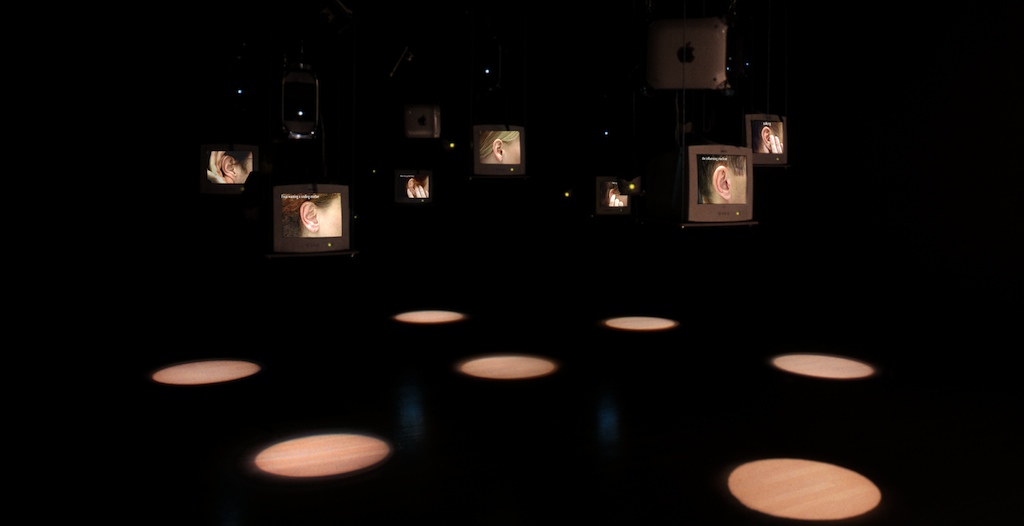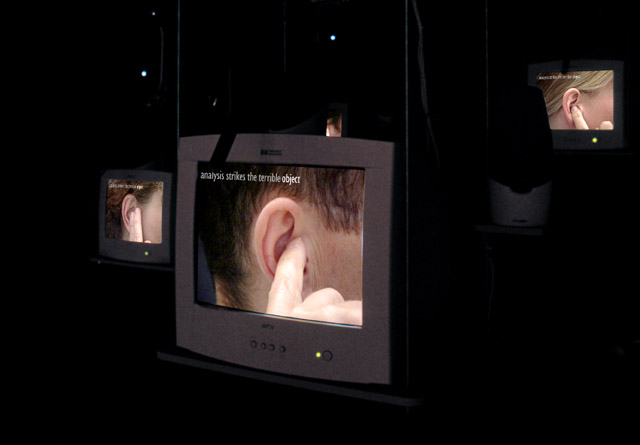
n-Cha(n)t installation view, Walter Phillips Gallery, Banff Centre for the Arts

n-Cha(n)t installation view, Walter Phillips Gallery, Banff Centre for the Arts
The surface inspiration for n-Cha(n)t was a strong and somewhat inexplicable desire to hear a community of computers speaking together: chattering amongst themselves, musing, intoning chants... It is probably significant that my father is a retired Anglican minister, and that I spent many Sundays in my youth fascinated by the subtle shiftings of voices speaking in unison… the sudden sibilance of shared s's… the slight variations with words forgotten or older versions preferred.
Over the past 10 years I have been developing a work entitled "The Giver of Names" which is a sort of subjective entity with a reasonable facility with language. It attempts in its rather idiosyncratic way to describe the objects that are presented to it. After spending a considerable amount of time with "the Giver of Names" I found that its grammatical slips, unconventional word choices and awkward sentence structures began to merge into something more concrete... a wacky but consistent dialect of English expressing a highly idiosyncratic but significantly coherent point-of-view. I would consider this system intelligent only in the most limited sense of the word, and it is certainly not conscious, but I do find myself projecting "loneliness" onto it.
"The Giver of Names" is awash in a sea of a language it can manipulate but cannot understand. Its plight and its 'loneliness' seemed to demand a social group. So I imagined a group of intelligent agents, hanging out in some corner of the internet during their idle time, jamming with their synthetic wits... trying out language on each other... perhaps finding their own patois... making this alien language somehow their own.
So n-cha(n)t is a community of "Givers of Names" linked by a network. They intercommunicate, and through doing so, 'synchronize' their individual internal 'states of mind'. When left uninterrupted to communicate amongth themselves, they eventually fall into chanting, a shared stream of verbal association. This consensus unfolds very organically. The systems feel their way towards each other, finding resonance in synonyms and similar sounding words, working through different formulations of similar statements until finally achieving unison.
Each entity is equipped with a highly focussed microphone and voice recognition software. When a gallery visitor speaks into one of the microphones, these words from the outside "distract" that system, stimulating a shift in that entity's 'state of mind'. As a result, that individual falls away from the chant. As it begins communicating this new input to its nearest neighbours, the community chanting loses its coherence, with the chanting veering towards a party-like chaos of voices. In the absence of further disruptions, the intercommunications reinforce the similarities and draw the community back to the chant.

n-Cha(n)t installation detail, Walter Phillips
Gallery, Banff Centre for the Arts
The ears visible on the computer monitors show the state of receptivity of each system. When the system is ready to listen, a listening ear is shown on the screen. If the system hears a sound, it cups its ear to concentrate. When 'thinking', a finger is pressed into the ear. If the system feels overstimulated, it covers its ear with a hand to indicate its unwillingness to listen.
As a system processes speech, the incoming words are displayed in the ear on the monitor. After the incoming speech finishes, the system muses on the input as it internally follows associative links stimulated by the input, and then it resumes speaking, using the recent stimuli as dominant themes of the stream of thoughts.
I am not trying to do any deep modelling of human social groups with this work. My entities are far too crude to be useful simulacra of real people. They represent nothing more than themselves... indentured slaves of this particular programmer, granted a fraction of some freedom they are utterly incapable of desiring. (next)
Also see Audio Hyperspace for an interview with David regarding n-cha(n)t.
Copyright 2002 David Rokeby / very nervous systems / All rights reserved. 4/7/02